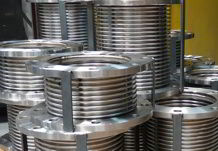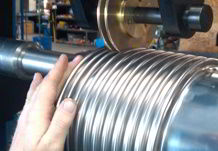METAL EXPANSION JOINTS INSTALLATION AND MAINTENANCE INSTRUCTIONS
Below are our EJMA recommended metal expansion joints installation instructions. To avoid any damage to the joints, please install your custom metal expansion joints according to the provided directions.
General Expansion Joint Installation Guidelines
- An expansion joint bellows must be constructed of relatively thin gauge material. This requires special installation and handling precautions. Failure to follow to these instructions may cause damage to the expansion joint and void all warranties. This damage may also cause premature failure or a shortened cycle life.
- Many cleaning agents, soaps, and solvents contain chlorides can cause stress corrosion. If cleaning the bellows surface is necessary, use only isopropyl alcohol and clean soft rags.
- Wire brushes, steel wool, and other abrasives should not be used on the bellows surface.
- Only use chloride free insulation to insulate the expansion joint bellows.
Storage of Metal Expansion Joints
- It is recommended that the expansion joint be stored in a secure area to prevent damage. Shipping bars must remain in place during storage and installation. Care must be taken to avoid any mechanical damage that may be caused by bumping, dropping, or stacking.
Removal of Old Expansion Joint
- The location into which you will perform the expansion joint installation should be examined to verify that the opening does not exceed the installation tolerances designated by the designer and/or purchaser. Expansion joints are not meant to make up for severe piping misalignment. In some cases, the opening may spring closed. If this is the case, the piping may require modification. If there is any misalignment greater than the design specification, consult the manufacturer, prior to installing the expansion joint.
Handling Expansion Joints
- Handling Expansion Joints
- Shipping bars should not be used as lifting devices. Some expansion joints may have lifting lugs incorporated into their design. The lighter expansion joints should be transported by their ends, never by the bellows section. Do not use chains or other handling devices directly on the bellows surface. Severe damage to the bellows surface will result.
- Shipping bars (painted yellow) are installed on the expansion joint to maintain the engineered bellows length and to provide stability for the unit during shipping. Do not remove the shipping bars until the expansion joint installation is complete.
Preparation to Install Metal Expansion Joints
- You must remove any protective covering from the ends of the joint in order to perform expansion joint maintenance. Visually inspect the inside of the expansion joint to make sure there are no foreign objects. If a flow liner is incorporated in the expansion joint design, be sure to orient the expansion joint with the flow arrow pointing in the direction of the flow. Installing the expansion joint in the wrong direction will result in premature failure of the joint.
- Using lifting lugs or proper lifting devices position the expansion joint in the desired location in the piping system.
Metal Expansion Joints Installation
Weld End Expansion Joints
- Prior to any welding or grinding wrap the bellows with a fire retardant blanket. This will prevent any damage from weld spatter.
- Using the correct filler metal and weld procedures, weld the expansion joint to the adjacent ducting.
Flanged Expansion Joints
- After the expansion joint has been positioned, orient the bolt holes of the expansion joint with those of the mating flange. NEVER torque or twist the bellows to line up the bolt holes. For new construction, it is recommended to leave one of the adjacent flanges loose until the expansion joint is installed.
Pressure Testing
- Never use shipping bars to restrain the pressure thrust while pressure testing the piping system. All anchors and guides must be in place before testing. Testing pressure should never exceed 1-1/2 times the designed working pressure of the expansion joint.
Metal Expansion Joint Maintenance and Operation
- Immediately after the expansion joint is placed in service, inspect it to ensure the joint is absorbing the thermal movements correctly.
- Inspect the bellows for unanticipated vibration. Vibration will shorten the life of any metal expansion joint.
- Periodically inspect the expansion joint and the piping system. The frequency of inspections depends on the severity of the service, environmental concerns, and the safety of plant personnel.
Thank you for reviewing our metal expansion joints maintenance instructions. For questions please call Triad Bellows at 714-204-4444 or e-mail sales@triadbellows.com



